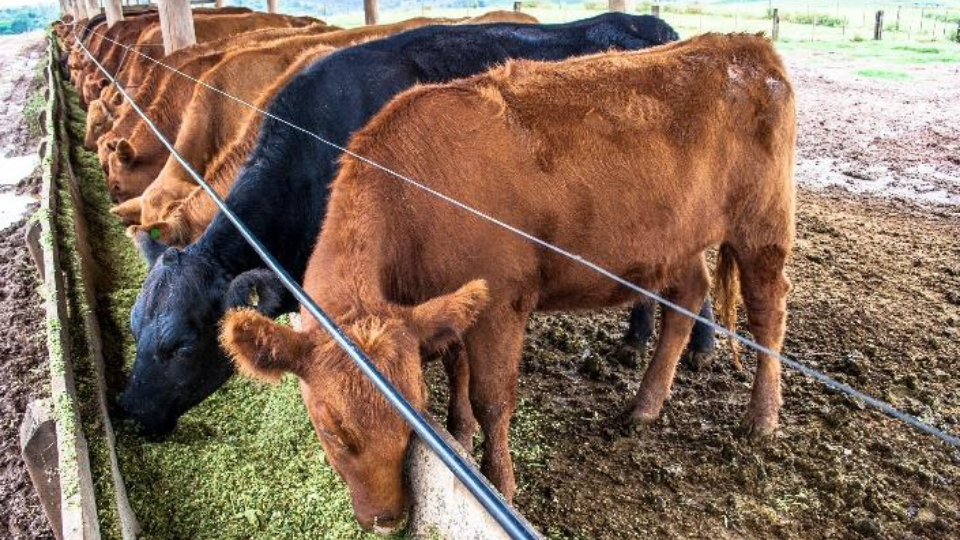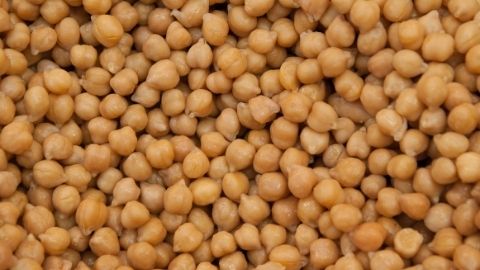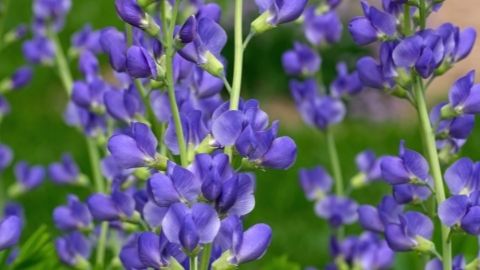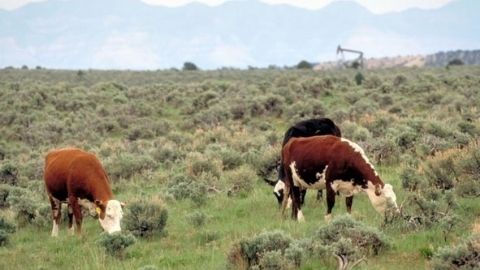Drought-Tolerant Options for Southwest Agriculture: Edible Produce
Introduction
The arid Southwest has been heavily impacted by drought and climate change. Temperatures in the region rose 2 degrees Fahrenheit in the last century and are expected to rise 3 to 9 degrees by the end of the century (Climate Impacts in the Southwest, 2016). The Southwest states are some of the driest in the nation. From 2000 to 2020, 65% of the state of Utah experienced abnormally dry conditions, 78% of Arizona, 69% of New Mexico, and 71% of Nevada. Water shortages are also common, especially in the late summer when water restrictions are often imposed. Drought levels of this magnitude damage pastures and crops, leading to economic losses in agriculture.
In the Southwest, American Indian farmers and ranchers provide an important economic base for rural areas. Sustaining agricultural production (crops, food, livestock) on tribal lands will become progressively more challenging in the future due to decreased water availability, extended droughts, and changes in precipitation quantities and timing. Close cultural and economic ties to natural resources, geographic remoteness, and economic challenges characterize American Indian reservations as some of the most vulnerable populations to climate change impacts (Melillo et al., 2014).
This fact sheet is the second in a series of three that provide an overview of drought-tolerant crops, grasses, and native plants, which may assist in maintaining agricultural production for food and feed and sustain grasslands and rangelands in the arid Southwest. The edible plants shown in Table 1 are traditionally used for human consumption and are all drought tolerant. These plants possess unique characteristics that enable them to thrive under dry conditions and other stresses. Their drought-tolerant features are discussed in addition to soil preferences, preferred growing conditions, and market conditions and profitability.

Chia/Desert Chia (Salvia hispanica L.)
Chia is desert plant cultivated for centuries by the Aztecs of ancient Mexico (Baginsky et al., 2016). Chia is grown across the globe, but Mexico is the largest producer (Natural Resources Conservation Service, n.d.). Chia is adapted to arid conditions and soils with low fertility and thrives in zones 8–11. Often called a “fire following” species (Natural Resources Conservation Service, n.d.), chia is an annual wildflower commonly planted directly into flower beds or bordering areas. Chia requires full sun, good soil drainage, and only enough water to become established. Avoid planting chia close to lawns or other areas that receive regular watering.
Table 1. Edible Produce with Preferred Zones and Average Yield and Price
| Name | USDA Hardiness Zone | Average Yield | Average Price |
|---|---|---|---|
| Chia | Zones 8–11 | 650 lbs. per acre | $26.50 per lb. |
| Chokeberry | Zones 3–8 | 5–10 tons per acre | $10 per lb. |
| Mexican Sour Gherkin | Zones 4–12 | 200+ fruits per plant | $20 per lb. |
| Sunflower | Zones 4–9 | 2000 lbs. of seed per acre | $16–$22 per cwt |
| Tarwi | Zones 8–11 | 30 tons per acre | $3 per lb. |
| Tepary Beans | Zones 8+ | 350-1500 lbs. per acre | $6 per bushel |
| Wolfberry | Zones 2–7 | 7000 lbs. per acre | $14 per lb. |
| Pomegranate | 85 ℉ for 120+ days | 75 lbs. per tree | $7.80 per lb. |
Note. Citations for the above information are provided in the text below.
Seed yields are approximately 650 pounds per acre and sold to wholesale distributors for $26.50 per pound (Oyugi, 2020). Desert Chia (Salvia columbariae) is slightly different from the Mexican chia and is found in California, Nevada, Arizona, and New Mexico. Chia seed (Figure 1) is popular as a dietary supplement due to its high omega 3, vitamin, mineral, and fiber content (Baginsky et al., 2016).

Chokeberry (Aronia melanocarpa)
Chokeberry (Figure 2) is hardy to zones 3–8, grows as a medium-sized shrub, and tolerates full sun or partial shade (Viking Black Chokeberry-Aronia, 2021). It grows best in compost enriched loam. The Viking variety is self-fertile, requires no pruning, is drought tolerant, and resistant to native pests and diseases (Chokeberry Viking, n.d.). It also tolerates clay and wet and salty soils (Pleasant Run Nursery, 2020).
Reported yields vary from 5–10 tons per acre (Cooperative Extension: Agriculture, n.d.). Mature bushes yield 10–20 bushels per year (Boese, 2018), depending on plant age, health, soil conditions, and precipitation/irrigation. The berries can be sold directly to wholesale distributors or the public or as value-added products. The wholesale price is approximately $10 per pound in the Midwest (Boese, 2018), with value-added products bringing higher returns.
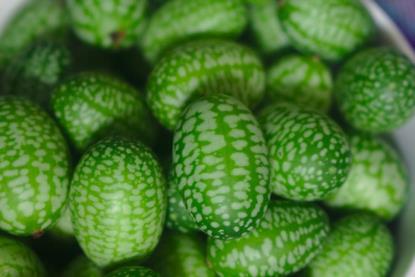
Mexican Sour Gherkin (Melothria scabra)
Sour gherkin originated in Mexico and Central America (Grant, 2018), requires full sun, fertile, well-drained soils with a pH of 5.5–7.0. It should be planted directly in the ground in late spring or early summer as plants require 60 days to reach maturity (Cucumber, Mexican Sour Gherkin, n.d.). These plants grow best in zones 4–12. For best growth, water weekly via drip irrigation and keep leaves dry to reduce disease (Cucumber: Mexican Sour Gherkin, n.d.). Compared to other members of the cucumber family, it is more cold-hardy and less water-hungry than its cousins (Grant, 2018). It has an extended harvest season, producing fruit well into the fall.
Sour gherkin are high yielding, with one plant producing hundreds of fruits (Figure 3). Revenues of up to $20 dollars per pound at farmers markets or farm stands in North America have been reported (Jabbour, 2018).

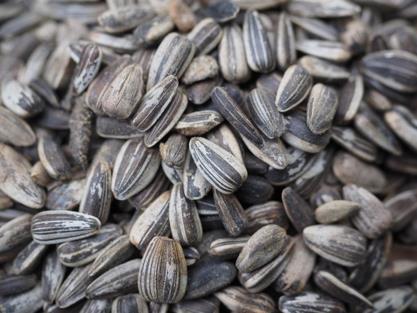
Sunflower (Helianthus annuus)
Sunflower (Figure 4a) is an annual native to North America and cultivated by Native Americans (Natural Resources Conservation Service, n.d.). Grow in well-drained soils, rich in organic matter (Delate, 2013) in zones 4–9 (Nardozzi, n.d.). Sunflowers have many purposes, including seed consumption or oil production from the seed (Figure 4b) (Delate, 2013). The stalks can be used as fuel or livestock feed and are grown in rotation with wheat. Sunflowers are common across North America and require full sun and irrigation until they are well established (Iannotti, 2019). Sunflower seeds attract birds and other animals; thus, protection may be needed while the plants are young.
Sunflowers yield about 2,000 pounds of seed per acre. Oil seed is valued at about $16 per cwt (hundredweight), while confection-type seeds return $22 per cwt (2019 USDA Sunflower, 2019). Domestic oil consumption is on the rise, which means the market looks healthy and can support new entrants.
Tarwi (Lupinus mutabilis)
Tarwi is a cool summer, nitrogen-fixing, droughttolerant, pest-resistant legume that grows well in marginal soils (Sattaur, 1988). Tarwi is hardy in zones 8-11, can fix 140 - 200 pounds of nitrogen per acre and requires very few nutrients in the soil (Tarwi, 2018). It also tolerates strong winds (Lupinus mutabilis, n.d.). Tarwi is a good cover crop, as well as a food crop, and can handle light frosts. It requires either acidic or neutral pH and grows well in climates similar to the Andean tuber crops (Sattaur, 1988). Tarwi can produce up to 30 tons per acre and sells for approximately $3 per pound (Cohen & Smale, 2014).
Tepary Beans (Phaseolus acutifolius)
Tepary beans are native annual legumes to the Southeast. They grow in washes and alluvial soils and are adapted to hot and dry areas. Currently, tepary beans are grown in Central America, Africa, Europe, and South Asia (Natural Resources Conservation Service, 2018). They are extremely drought tolerant and require little water (Skye, 2016) and grow wild in the Sonoran Desert. This legume is hardy to zone 8 and yields roughly 100 beans per plant. Beans sell for $6 per bushel when sold direct-to-consumer (Burgess, n.d.) and under dryland conditions yield 350–700 pounds per acre.
If irrigated, yields range from 800–1500 pounds per acre (Natural Resources Conservation Service, 2018). While there are currently only limited existing markets, there is room for expansion, particularly in regions with Native American or Hispanic populations.

Wolfberry/Goji Berry (Lycium barbarum)
This perennial shrub is hardy to zones 2–7 (Demchak & Bloom, 2020), is very drought tolerant, grows best in light, high fertility soils, and requires full sun. Goji berries do grow well in saline soil. During the establishment year, the root system needs to be well watered (Demchak & Bloom, 2020). However, in subsequent years, irrigation requirements decrease. Fertilize similar to tomatoes, adding 75–90 pounds of nitrogen per year, divided into three applications during bud-break, at flowering, and lastly, as the fruit begins to ripen (Figure 5) (Demchak & Bloom, 2020).
Goji berries are primarily grown in Canada, China, and California (Demchak & Bloom, 2020). In China, yields are reported at 7,000 pounds per acre (Demchak & Bloom, 2020), with price per pound around $14. There is potential in the current health food market for this crop.
Pomegranate (Punica granatum)
The pomegranate was initially cultivated in Asia and brought to America by the Spanish in the late 1500s (Hawkins et al., 2010). Plants are extremely drought and heat tolerant and grow well at temperatures over 85 degrees Fahrenheit. Pomegranates require a long, hot growing season, are moderately salt tolerant, and prefer a soil of pH 5.5–7.2. Pomegranate bushes take four years to establish prior to fruit production. Individual bushes can yield 20–25 fruits (Stein et al., 2015), and fruit numbers increase to 100–150 by year 10. A wellmanaged orchard typically produces 200–250 fruits per tree (75 pounds/tree) (Stein et al., 2015). The average wholesale price is approximately $7.80 per pound (Pomegranate, 2020).
Conclusions
The drought-tolerant edible plants and seed discussed here are options for maintaining agricultural production as climate change impacts the arid Southwest. While many of those discussed are native to the U.S. and used in Native American culture, others originated in other drought prone areas of the world. The plants discussed here are not an exhaustive list and other options may be equally useful and/or profitable. University Cooperative Extension and United States Department of Agriculture (USDA) publications regarding plant propagation, growing, harvesting, and marketing should be consulted when deciding on the best option for a specific area or region.
Picture Credits
- Figure 1. Kosinka, Joanna. (2017) Chia. Unsplash. https://unsplash.com/s/photos/chia
- Figure 2. Aronia berries chokeberry. (n.d.) WP Clipart. https://freeimages.com/display/aronia_berries_chokeberry.html
- Figure 3. SoFuego. (n.d.) Gherkin. Pixabay. https://free-images.com/display/gherkin_tiny_small_861550.html
- Figure 4a. Sunflowers in field (n.d.) Wikimedia Commons. https://freeimages.com/display/sunflowers_in_field.html
- Figure 4b. Hans (n.d.). Sunflower seeds. Pixabay. https://freeimages.com/display/sunflower_seeds_bird_seed_0.html
- Figure 5. Goji berry (2011). Wikimedia Commons. https://free-images.com/display/goji_berry_ningxia.html
References
- 2019 USDA Sunflower Production & Price Estimates. (2019). Retrieved May 13, 2020, from https://www3.nuseed.com/us/2019-usda-sunflower-production-price-estimates/
- Baginsky, C., Arenas, J., Escobar, H., Garrido, M., Valero, N., Tello, D., Pizarro, L., Valensuala, A, Morales, L, & Silva, H. (2016, September). Growth and yield of chia (Salvia hispanica L.) in the Mediterranean and desert climates of Chile. Chilean Journal of Agricultural Research, 76(3). http://www.bioline.org.br/pdf?cj16034
- Boese, V. (2018, November 30). Grow aronia berry for health and profit. Homestead Hustle. Retrieved May 13, 2020, from https://homestead.motherearthnews.com/grow-aronia-berry-for-health-and-profit/
- Brown Tepary Beans - S-OAM BAVI. (n.d.). Ramona Farms American Indian Foods. Retrieved May 12, 2020, from https://store.ramonafarms.com/Brown-Tepary-Beans-S-OAM-BAVI/productinfo/BTEPBR1/169/
- Burgess, M.A. (2021, October). The tepary connection: A visit with W. D. Hood. University of Arizona. https://repository.arizona.edu/bitstream/handle/10150/552170/dp_05_01-003-007.pdf?sequence=1
- Chokeberry Viking. (n.d.). Park Seed. Retrieved April 29, 2020, from https://parkseed.com/vikingaronia/p/35691/
- Climate Impacts in the Southwest. (2016, December 22). U.S. Environmental Protection Agency (EPA). Retrieved February 19, 2020, from https://19january2017snapshot.epa.gov/climate-impacts/climate-impactssouthwest_.html
- Cohen, M.J., &, Smale, M. (Eds.) (2014, June 11). Global food-price shocks and poor people. Routledge. Retrieved April 29, 2020, from https://books.google.com/books?id=JZDJAwAAQBAJ&pg=PT235&lpg=PT235&dq=what+is+the+cost+pe r+pound+of+tarwi&source=bl&ots=L24-7- TZYo&sig=ACfU3U0ogUE9kmDaL3v4unzohs3WoxuLyA&hl=en&sa=X&ved=2ahUKEwj0zNGcwv_oA hXKXc0KHUJtBlkQ6AEwAXoECAwQAQ#v=onepage&q=what is the cost per pound of tarwi&f=false
- Cooperative Extension: Agriculture. (n.d.). Culture of aronia for fruit production. University of Maine Cooperative Extension. https://extension.umaine.edu/agriculture/aronia/culture/
- Cucumber, Mexican Sour Gherkin. (n.d.). W. Atlee Burpee and Co. Retrieved April 29, 2020, from https://www.burpee.com/vegetables/cucumbers/cucumber-mexican-sour-gherkin-prod099645.html
- Cucumber: Mexican Sour Gherkin (Heirloom) (Melothria scabra). (n.d.). Project Purity Seeds. Retrieved April 29, 2020, from http://www.projectpurityseeds.com/store/p163/Cucumber:_Mexican_Sour_Gherkin_(Heirloom)_(Melothria _scabra).html
- Delate, K. (2013). Alternative Agriculture: Sunflower. Iowa State University Extension and Outreach. https://www.extension.iastate.edu/alternativeag/cropproduction/sunflower.html
- Demchak, K., & Bloom. (2020, April 19). Goji berry culture. PennState Extension. https://extension.psu.edu/goji-berry-culture
- Gardening Know How. (2020, February 11). Chia plant care: Learn how to grow chia seeds in the garden. Retrieved August 13, 2020, from https://www.gardeningknowhow.com/edible/herbs/chia-plant/how-togrow-chia-seeds.htm
- Grant, A. (2018, April 4). What are cucamelons: How to plant Mexican sour gherkins. Gardening Know How. Retrieved April 29, 2020, from https://www.gardeningknowhow.com/edible/vegetables/mexican-sourgherkins/what-are-cucamelons.htm
- Hawkins, G.L., Sparks, A.N., & Acebes, A.L. (2010, July 1). Pomegranate production. University of Georgia Extension. https://extension.uga.edu/publications/detail.html?number=C997&title=Pomegranate Production
- Iannotti, M. (2019, October 28). Learn how to grow and care for sunflowers in your garden. The Spruce. Retrieved April 29, 2020, from https://www.thespruce.com/growing-sunflowers-1402916
- Jabbour, N. (2018, June 30). Learn how to grow crispy, crunchy cucamelons in your garden. Savvy Gardening. Retrieved April 29, 2020, from https://savvygardening.com/growing-cucamelons-in-a-garden/
- Lupinus Mutabilis – Sweet. (n.d.). Plants for a Future. Retrieved April 29, 2020, from https://pfaf.org/user/plant.aspx?LatinName=Lupinus+mutabilis
- Melillo, J.M., Richmond, T.C., & Yohe, G., Eds. (2014) Climate Change Impacts in the United States: The Third National Climate Assessment. U.S. Global Change Research Program. doi:10.7930/J0Z31WJ2.
- Mexican Sour Gherkin (a). (n.d.). Territorial Seed Company. Retrieved April 29, 2020, from https://territorialseed.com/products/cucumber-mexican-sour-gherkin
- Mexican Sour Gherkin (b). (n.d.). H.R. Seeds. Retrieved April 29, 2020, from https://www.hrseeds.com/mexican-sour-gherkin
- Mexican Sour Gherkin Seeds. (n.d.). Park Seed. Retrieved April 29, 2020, from https://parkseed.com/mexicansour-gherkin-seeds/p/52634-PK-P1/
- Natural Resources Conservation Service. (n.d.). Salvia hispanica L, chia. Plant Database, U.S. Department of Agriculture. Retrieved April 29, 2020, from https://plants.usda.gov/home/plantProfile?symbol=SAHI6
- Natural Resources Conservation Service. (n.d.). Helianthus annuus L.,annual sunflower. Plant Database, U.S. Department of Agriculture. Retrieved April 29, 2020, from https://plants.usda.gov/home/plantProfile?symbol=HEAN3
- Natural Resources Conservation Service. (2018, September). Phaseolus acutifolius, tepary bean. Plant Database, U.S. Department of Agriculture. Retrieved April 29, 2020, from https://plants.usda.gov/home/plantProfile?symbol=PHAC
- Nardozzi, C. (n.d.). All about sunflowers. American Meadows. Retrieved April 29, 2020, from https://www.americanmeadows.com/wildflower-seeds/sunflower-seeds/all-about-sunflowers
- Oyugi, Z. (2020, February 6). Markets [Magic chia seeds earn farmer Sh1500 per kilo]. Farmbiz Africa. Retrieved May 13, 2020, from https://www.farmbizafrica.com/markets/3062-chia-offers-sh1m-an-acre-peryear-as-new-wonder-crop
- Pleasant Run Nursery, Inc. (2020). Aronia melanocarpa 'Viking'. Retrieved April 29, 2020, from https://www.pleasantrunnursery.com/plantname/Aronia-melanocarpa-Viking
- Pomegranate. (2020). Real-Time pomegranate prices in the United States. Tridge. Retrieved May 14, 2020, from https://www.tridge.com/intelligences/pomegranate/US/price
- Sattaur, O. (1988, June 2). Native is beautiful. New Scientist 118(1615), 54. Retrieved April 29, 2020, from https://books.google.com/books?id=vfbyQT4m9ucC&pg=PA55&lpg=PA55&dq=yield+of+tarwi+per+acre &source=bl&ots=je4nBtKViW&sig=ACfU3U2XZH_sNYADgeTlwsz_xe4VVFc0Q&hl=en&sa=X&ved=2ahUKEwj56bGYwf_oAhVEGM0KHd41CiQQ6AEwCXoECAkQAQ#v=one page&q=yield of tarwi per acre&f=false
- Skye, J. (2016, October 7). The bean varieties for hot weather. SFGate. Retrieved April 29, 2020, from https://homeguides.sfgate.com/bean-varieties-hot-weather-41189.html Stein, L., Kamas, J., & Nesbitt, M. (2015). Pomegranates. Texas A & M Agrilife Extension. https://aggiehorticulture.tamu.edu/fruit-nut/files/2015/04/pomegranates_2015.pdf
- Sunflower Seeds, Raw Shelled (Kernels). (2021). Anuts.com, Argires Snacks. Retrieved April 29, 2020, from https://www.anuts.com/seeds/sunflower-seeds/sunflower-seeds-raw-shelled-kernels/
- Tarwi (Lupinus mutabilis). (2018, September 12). Cultivariable - The Cultivariable Growing Guide. Retrieved April 29, 2020, from https://www.cultivariable.com/instructions/other-vegetables/how-to-grow-tarwi/
- Viking Black Chokeberry. (2021). Monrovia Nursery Company. Retrieved April 29, 2020, from https://www.monrovia.com/plant-catalog/plants/4526/viking-black-chokeberry/
- Viking Black Chokeberry - Aronia. (2021). High Country Gardens. Retrieved April 29, 2020, from https://www.highcountrygardens.com/perennial-plants/shrubs/aronia-melanocarpa-viking-black-chokeberrytree
Authors
Emily Rice, Extension Intern, Department of Applied Economics; Kynda Curtis, Professor and Extension Specialist, Department of Applied Economics
Related Research


 Utah 4-H & Youth
Utah 4-H & Youth
